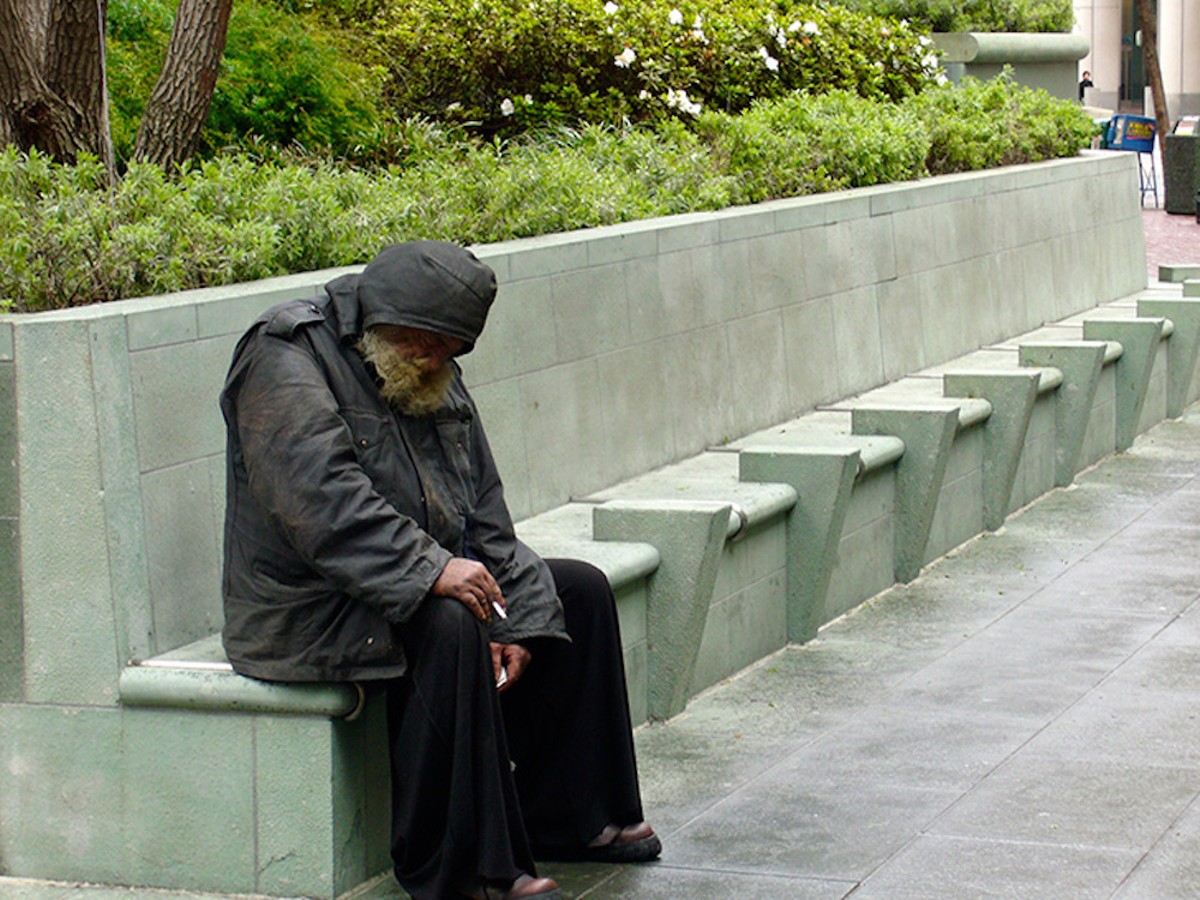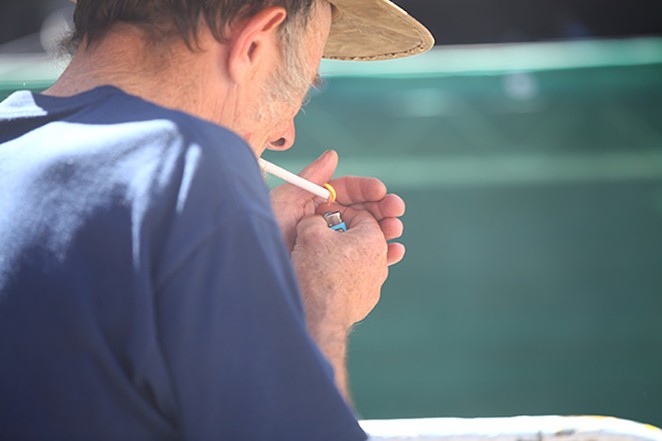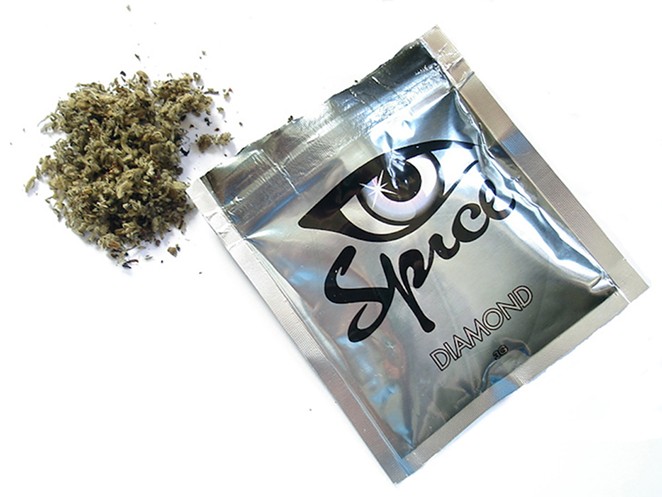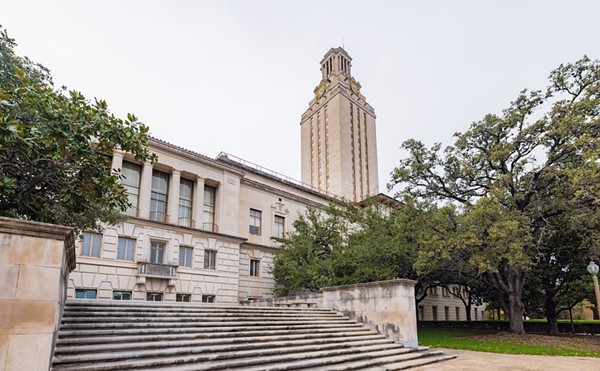Amy has long blonde hair. She wears a pink leopard-print top and blue jeans with deep pockets. One blue cloth rosary hangs around her neck, a brown one wraps around her wrist. She's shoeless, and her feet are grimy. Blood has crusted around the rim of one of her big toenails. She has a deep cut above her left eye that's still healing. Instead of a scab, a small ball of dead skin has formed abnormally in the middle of the wound.
Amy is homeless, and she's trying to sell me synthetic marijuana outside the Pik Nik Foods convenience store on Commerce Street. The going rate is about $5 for a joint or $40 for a bag, which is roughly enough for five joints. Our potential transaction ends when I tell her I don't have any cash.
Amy, unconvinced that I was a reporter and not a cop, wouldn't tell me her last name. She says that she and her boyfriend sell two to three bags of synthetic marijuana a day, almost exclusively to other homeless people. She started selling the drug instead of panhandling, which police seldom allow in the Downtown area. And while she's aware of some of the risks, they haven't stopped her from smoking synthetic marijuana "all the time."
"If you have seizures you're not supposed to smoke it," Amy said. "If it's good shit it puts you to sleep and you pass out."
The problem is, it's not all good shit. Sometimes it's bad shit – really bad – and it has the potential to cause serious health problems. Sometimes it's fatal.
Synthetic marijuana isn't really marijuana at all. It's often marketed as potpourri or incense, and made out of a plant base that's then sprayed with a chemical cocktail. When smoked, it's supposed to emulate the effects of regular weed. Technically, most strains are illegal in Texas, but manufacturers can skirt laws that ban the substance by slightly altering the chemical composition of their spray.
Even as the state has led efforts to stifle synthetic marijuana usage in Texas – notably through a 2015 law meant to cast a wider net for potential chemical compounds – the drug's popularity among San Antonio's homeless population has surged over the past year or so.
The reasons for this are practical and market-driven. Synthetic marijuana – primarily called Klimax on San Antonio streets but also Kush, Spice, K2 and other names – is cheap, readily available, potent and tough to be prosecuted for. It's an ideal drug for people with few resources who struggle with mental health issues or substance abuse.
"I can make five bucks in five minutes. Then I can smoke something so that I can escape for four hours," said Brian Clark, assistant medical director of restoration services at the Center for Health Care Services. "I don't have a dollar to my name, I don't know where my kids are, I have Hepatitis C or HIV ... Why wouldn't I want to escape? What else do they have to look forward to? It's a quality buy."
The center primarily treats homeless people and others who are unable to pay for their own care, and Clark's unit specializes in patients with drug and alcohol problems. Of the roughly 600 patients Clark and his colleagues treated in September 2014, only eight reported using synthetic marijuana. That number shot to 223 by July 2015, and though it's decreased some since then, Clark claims that usage is still rampant.
'He Was a Good Person'
Smoking synthetic marijuana can have serious consequences for the health of its users. But the allure of a cheap, deep high is sometimes too much to resist.
"If you're on Kush, your voices go away. So you can chill, you can sleep, if you have the right dose," said David Miramontes, medical director for the San Antonio Fire Department. "You don't feel that pain, that depression ... This is an escape from all those things that they view as problematic."
Between 2010 and 2015 the Texas Poison Control Network received over 3,500 calls reporting synthetic marijuana exposures. Many of those reports included symptoms such as confusion, vomiting and agitation. More serious symptoms included seizures, hallucinations and tremors. The most common symptom was an abnormally rapid heart rate. Only four of the calls – less than a tenth of a percent – resulted in deaths.
Experts say that smoking synthetic marijuana just once can be enough for serious long-term effects.
"A lot of times they can have prolonged psychosis, which is very hard to treat. It has changed the chemical structure and the electric system in the brain, so now they have a psychosis similar to schizophrenia," Miramontes said. "We have a number of cases ... that have been very hard to manage. It's taken up to a year to get themselves in control so they can function in the community. Very horrific damage was caused."
Part of the problem is that the drug's volatile nature means effects can differ between both users and batches. The lack of quality control makes every toke like playing Russian roulette.
"First of all we don't know what the leaves are, second we don't know what the drug is. So there's no quality control, there's no dose control. You get a 10 milligram Percocet, you know you've got 10 milligrams in there. You've got no idea with this stuff, that's why it's so easy to overdose," Miramontes said.
Tina Pihota believes that's what happened to her son, Joseph, who died on May 3, 2015 in Lavaca County. Both he and his mother lived in San Antonio then.
Tina said her son, 28 at the time of his death, had been smoking lots of synthetic marijuana up until he died.
"He smoked it every day, all day, for five months. If he didn't smoke every 15 to 20 minutes he was getting sick," Pihota said. "It made him paralyzed, almost motionless like he was stuck in the same position for maybe 15, 30 minutes. It kind of made him dumb, like simple."
Pihota died in the custody of local police after they found him running around in a field and acting erratically, according to the Victoria Advocate. Pihota was a father and struggled with drug addiction in the past. After his death, Tina started a foundation to raise awareness about the drug's risks and keep kids away from it.
"I started [the foundation] to give his death meaning, I wanted to honor him somehow. He wasn't just a drug addict, he was a good person," Pihota said.
Five Bucks a Joint
Pihota said her son would buy synthetic marijuana under the table from local gas stations and head shops. Of the list of over a dozen businesses she'd been told sell it, none were willing to sell to this reporter. Most vehemently denied stocking it, or appeared confused when asked for Klimax or Spice.
"The stores that sell this are very savvy," Miramontes said. "Bob homeless guy – [they] know Bob. Bob comes every morning and he gets his Kush and his Monster drinks ... You go in that same store, you say 'Hey, I want some Kush,' the store owner doesn't know you. They're smart. They know their population and their base."
Even if a business were to be found selling synthetic marijuana, it's difficult to prosecute since the tests to verify the legality of the chemical structure can be time-consuming and expensive. Law enforcement may hesitate to commit resources to stop a crime that may not be fruitful.
A study conducted by San Antonio Emergency Medical Services showed that most of the psychosis or overdose calls related to synthetic marijuana came from the 78207 ZIP code, which encompasses the area west of Downtown, including Haven for Hope.
Sitting on a curb a couple blocks from Haven, Charles Dennis, 53, said he's smoked synthetic marijuana several times, "just to see what it's like."
"It's a different high, but I'd rather have regular weed," Dennis said.
Dennis is a homeless alcoholic who used to roof and remodel houses. He grew up in South Carolina, left school in the 10th grade, and developed a drinking problem shortly afterwards that he's never been able to shake.
Wearing a short, gray beard and pristine, white New Balances, Dennis labored to shuffle through the streets near the new Centro Plaza where homeless people often congregate, asking for change or to buy him a beer.
He described the high from synthetic marijuana, which he buys at Downtown gas stations or from other homeless people, as debilitating.
"I used to shingle roofs after smoking regular weed," he said. "I ain't getting on no roof after smoking Klimax."





















